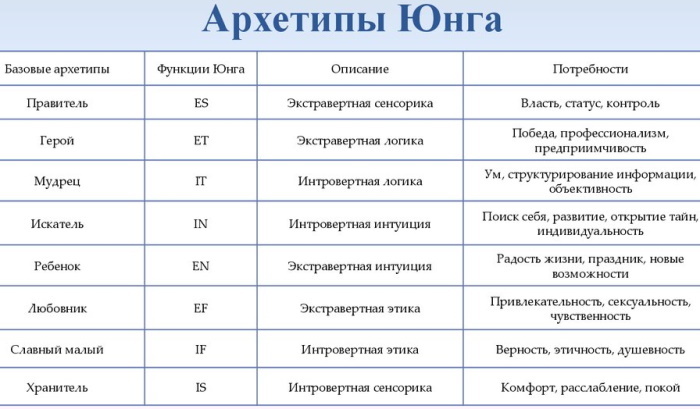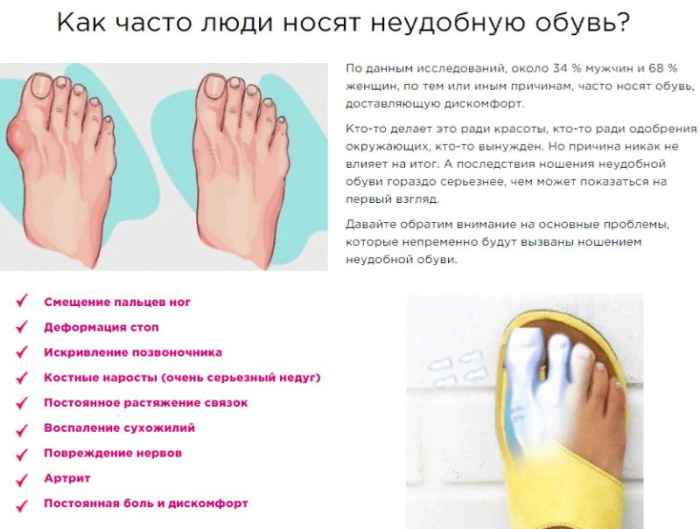Content
- Danger of water getting into ears
- How to shake the water out by jumping
- With a napkin
- Lying on its side
- Chewing movements
- Vacuum method
- Yawn
- Warm compress
- Hairdryer
- Inhalation method
- Valsalva maneuver
- Can I bury something?
- When should you see a doctor?
- What to do to prevent the situation from repeating itself?
- Video on how to remove water from the ear
Penetration of water into the structure of the auditory organ causes significant discomfort, painful sensations and can lead to the development of ENT diseases of an inflammatory nature. Natural reservoirs containing pathogenic microorganisms are especially dangerous. There are several ways to pour fluid out of your ear.
Danger of water getting into ears
This situation often arises after taking a bath and visiting the pool, where the water is disinfected by chlorination. This chemically aggressive substance destroys bacteria, but when it enters the auricle, it causes tissue edema, severe irritation of the skin and other unpleasant effects.

If the fluid from the auditory tube is not promptly removed, complications will develop and complex treatment will be required. The water is not sterile, so there is a high risk of infection. It does not evaporate on its own, since the auditory organ is in a moist state.
You can pour the water out of your ear by chewing, blowing a hair dryer, or using other methods. If they do not bring the expected effect, you will have to seek medical help. The fluid accumulates in the tortuous canals of the auditory tube and causes pathological disturbances in the work of the acoustic organ. The ear has a complex anatomical structure.
It consists of 3 departments and several additional segments:
- Outside. This is the lateral portion of the biological auditory system. It consists of 2 elements - the ear canal with an adjacent shell. The extended design of the latter is due to the easy flow of liquid.
- Average. It occupies an intermediate position between the external and internal parts of the auditory organ. It includes a tympanic cavity filled with water when flowing, which impairs the perception of sound waves.
- Internal. The most difficult section of the human acoustic system. It has a labyrinth-like structure and intricate shape. This makes it difficult to remove any liquid that has entered it.
- Eustachian tube. Connects the middle ear organ with the nasopharyngeal cavity. Has numerous functional purposes. One of them is to create a barrier to pathogenic bacteria. Their content in the liquid trapped in the Eustachian tube provokes the development of inflammatory processes and infection of internal organs.
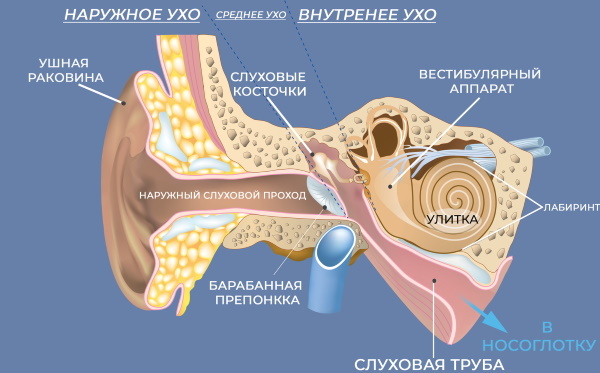
Often, water that has entered the ear does not penetrate the acoustic canal of the outer section. The eardrum, which is a film membrane with a thickness of about 100 microns, serves as an obstacle in its path. It is completely impervious to liquids, dust particles, atmospheric air. The functional purpose of the eardrum is the perception and transmission of sound waves.
Along the way, it protects the internal structures of the speaker system from contamination, including non-sterile water. Sometimes the fluid is able to overcome the eardrum and penetrate deep into the biological auditory analyzer. This happens when water is poured into the nasal sinuses, coupled with the internal section of the acoustic organ by the Eustachian tube. The channel is designed to equalize the compression load to which the tympanic membrane is subjected.
This ensures its normal functioning. Along the ascending path, the fluid rises to the middle section of the auditory system. Its further advance is impeded by waterproof membranes.
But this is enough for the development of a special form of otitis media, called "swimmer's ear". The disease is an inflammation of the walls, epithelium and skin of the external acoustic passage.
Typical symptoms:
- otalgia - excruciating ear pains;
- a feeling of constant congestion in one or both ears;
- hearing impairment;
- subfebrile body temperature;
- otorrhea - the release of pathological exudate from the auditory shell.

With the progression of the disease, an increase in cervical lymph nodes is observed, headaches develop, and facial nerves become inflamed. The condition can be life-threatening and require hospitalization. Pouring water from the ear as soon as possible is especially necessary for people with previously damaged walls of the ear canal - scratches, ulcerative foci, cuts. They are most vulnerable to otitis media.
At high risk are patients with contact dermatitis, chronic eczema or psoriasis, congenital tendency to allergic reactions. Bacterial infection and the development of fungal microflora can provoke diseases outside the ear organ.
How to shake the water out by jumping
If the fluid has not penetrated beyond the eardrum, there is no problem with removing it from the ear tube. The situation is significantly complicated when water enters the middle ear, where it gets stuck in the tortuous canals and forms a lens-shaped plug in the cavities. Mixing it with exudate or sulphurous deposits increases the viscosity of the liquid, which makes it difficult to remove. The auditory organ must be positioned parallel to the earth's surface.
To do this, the head is tilted sideways to the left or right - towards the affected ear. The easiest and fastest way to remove fluid from the structure of a loudspeaker is to jump on one leg. It is effective in the first minutes after the flow of water, until it has had time to spread far. Jumping will only get rid of a small amount of fluid. The auditory canal must be placed in a horizontal position by tilting the head strongly.

They jump on the leg from the side of the affected ear. Reception will not work if the liquid has reached the drum membrane. It may not be effective due to the complex individual structure of the auditory tube and auricle. A large amount of sulfur deposits, a special physiological state of the villi that retain fluid, can prevent the flow of water. If the trick does not work, it is recommended that you resort to the methods outlined below.
With a napkin
The method is recommended by otolaryngologists for home use. It is considered completely safe and easy to implement on your own. You will need an ordinary disposable paper sanitary napkin. It is better to use a thick and dense multi-layer accessory. A thin cloth quickly breaks down when it comes into contact with liquid. Particles of paper can get stuck in the ear canal, exacerbating the situation. The napkin must be folded into a triangle.
It is folded several times to increase the density of the hygienic device. The middle part of the napkin is rolled to stiffen the paper product. As a result of the manipulations, you get an impromptu turunda with a soft end. It is slowly immersed in the auricle. The device will destroy the water plug, and absorbent paper will absorb excess liquid and particles that clog the ear canal.
The method is absolutely painless. Soft paper will not scratch the skin or cause other damage. The tissue can easily be brought up to the eardrum itself without adversely affecting the speaker system.
To drain the liquid from the ear canal, you can use regular dry table hygiene items. It is undesirable to use wet wipes with bactericidal and antiseptic properties, make-up removers and other specialized options with impregnation to clean the ear from water.
Lying on its side
The variant with the adoption of a horizontal body position is slightly more effective than the previous method. You can use the bed. You need to lie down on it, hanging your head towards the injured ear. To provide comfort and adjust the angle of the auricle, it makes sense to use a pillow.

It is enough to lie down for 15-30 minutes. depending on the depth of water inflow, so that it flows out naturally under the influence of gravitational attraction. The method will have no effect if the fluid has penetrated too deep into the anatomical structure of the auditory organ. Sometimes it helps to stay in a horizontal position for a long time.
Chewing movements
Intensive work of the jaw muscles contributes to the removal of fluid from the auditory tube. Reflex chewing movements can push out some water, but this method can hardly be called effective.

It is used after swimming in an open reservoir, when there are no means suitable for removing fluid from the ear canal at hand. Chewing movements can be combined with jumping on one leg. The head should be tilted towards the congestion. You can use chewing gum or mimic such movements with a jaw apparatus. Reflex contraction of the facial muscles is caused by spicy foods, any hot food or drink.
Vacuum method
The technique is more effective than the previous ones.
There are 3 options for removing the water block:
- The stuffed-up ear is clamped with a hand with effort, blocking the access of air to the inside of the auditory concha. Then, with a sharp jerk, the palm is torn off, creating vacuum pressure. A physical principle is used that is identical to pipe cleaning with a plunger.
- The auricle is clamped with a finger, and the lobe is pulled with the other hand. As a result, a vacuum is created inside the ear canal by increasing its volume without changing the amount of air. Releasing your finger abruptly ensures that water flows out.
- Strong forward bend with fast extension. The method creates a centrifugal force inside the auditory canal, which adheres the liquid to one of the walls and directs it towards the exit.
The last option is undesirable to use for people who are contraindicated in sudden movements.
Yawn
Method similar to the previous one. Yawning movements should be done while lying on your side and tilting your head towards the congestion. On the beach, you can put a towel under your face, and use a pillow at home. Yawning is alternated with swallowing and chewing movements.
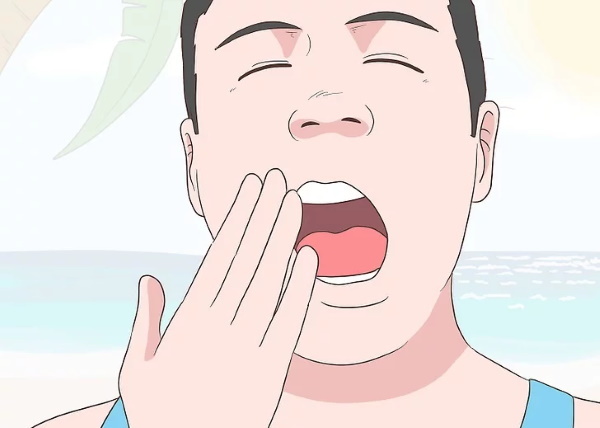
The work of smooth muscle structures is theoretically capable of tearing off the water plug from the walls of the auditory canal or moving it closer to the exit from the auricle.
Warm compress
An effective option for opening the Eustachian tube to drain fluid from it. The technique is relevant when water enters the cavity of the middle section of the organ, separated from the outer segment by an impenetrable tympanic membrane. This situation often develops when inhaled while diving in a pool or natural body of water. In this case, the previous methods will not bring the expected result.
You can pour the water out of your ear or quickly evaporate it using a warm compress. The temperature effect, which expands the Eustachian tubes, will ensure the drainage of fluid into the nasopharyngeal cavity, from where its removal is not difficult. An impromptu compress is made from a cloth or towel soaked in hot water. The hygiene item is wrung out and applied for 30 seconds. to the auricle.
The procedure is repeated until the fluid is completely removed from the ear. You can lie on the bed with a warm compress, tilting your head towards the congestion. This will speed up and facilitate fluid drainage.
Hairdryer
It is necessary to set the operating mode of the household electrical appliance to generate cold air. The hair dryer is placed 30-40 cm from the stuffy ear. The method cannot be called absolutely safe. Use a hairdryer to remove fluid from the ear canal with utmost care. Air flow can dry out the ear. It is important not to overcool the acoustic organ. This can lead to the development of an inflammatory process.
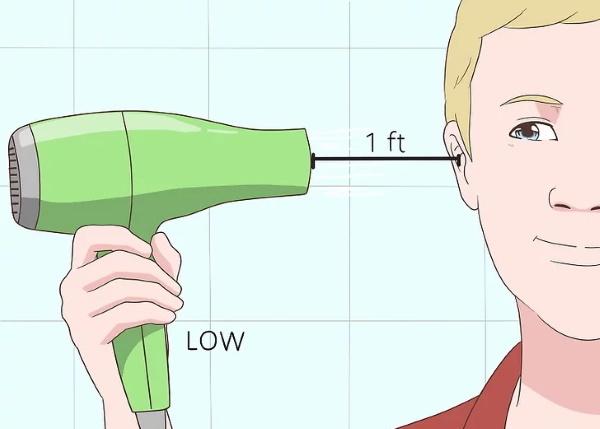
It is strictly forbidden to switch the hair dryer to the hot air generation mode. There is a risk of burning the thin skin or damaging the sensitive eardrum. An alternative to a hair dryer is an enema. It is not inserted into the ear canal, but kept at a distance, by squeezing air blowing out in the direction of the stuffy ear. After a few minutes of this intensive process, the auditory tube will dry out.
Inhalation method
Drying the ear canal is similar to the previous one. It is based on the temperature effect on the acoustic organ. Warm steam is supplied by inhalation. The procedure is dangerous because there is a possibility of burns to the skin or eardrum.
It is important to choose the right heat exposure temperature. Hot water is poured into a metal dish and a stuffed ear is held over it, covering the head with a towel so that steam does not escape into the environment, but gets inside the auditory tube.
Do not bring the acoustic organ too close to the container to avoid scalding. After 10-15 minutes. exposure to temperature, the liquid should evaporate. If water gets into the middle section of the auditory organ, you need to breathe hot steam. It will widen the Eustachian tubes and allow water to drain into the nasopharyngeal cavity.
Valsalva maneuver
The procedure is named after the Italian physiologist and otolaryngologist Antonio Valsalva. He developed a special technique for removing fluid from the middle section of the auditory organ. The technique is based on the organization of air movement through the Eustachian tube, as a result of which the pressure is equalized between the sinus cavities of the skull and the environment. This ensures that the liquid is pushed outward.
To perform the Valsalva maneuver, you need:
- Pinch your nostrils with your fingers.
- Close your lips tightly.
- Tighten your vocal cords.
- Bring the stuffed ear closer to the shoulder.
- Take a deep breath.
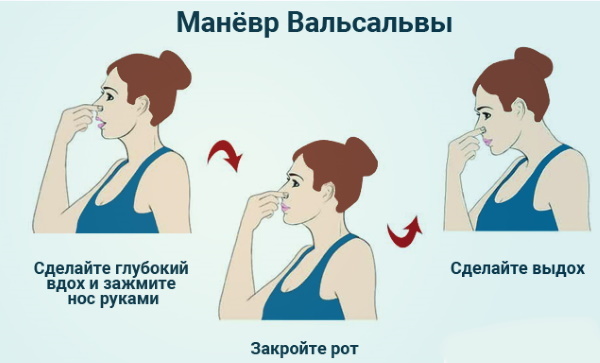
There should be a clap in the area of the eardrum, which indicates a successful purge. The procedure is contraindicated in acute respiratory infections. Pathogenic bacteria can penetrate into the middle section of the auditory organ, which provokes inflammatory otitis media.
The Valsalva maneuver dramatically increases blood pressure. It is dangerous for patients with vegetative-vascular dystonia, disorders of the heart organ and hypertension. Careless purging can damage the eardrum.
Can I bury something?
Some medications can help drain or evaporate the water from your ear. Medicines and home recipes should be used only after prior consultation with an otolaryngologist. The integrity of the water plug is effectively broken by alcohol-containing solutions.
Recommended drip products are presented in the table:
| Solution | Instructions for use |
| Vinegar with alcohol in a 1: 1 ratio | Vinegar prevents the reproduction of pathogenic microflora, and alcohol quickly evaporates the liquid. With a sterile pipette, 3-4 drops of the solution are injected into the congested ear. Then the head is tilted towards the congestion, facilitating the flow of fluid. It breaks down earwax, which traps moisture. |
| Boric acid | 2-3 drops of the substance are pipetted into the auricle. Under its action, the liquid evaporates in 45-60 minutes. |
| Naphtizin | The drug belongs to the pharmacological category of alpha-adrenergic agonists. When in contact with the mucous membrane, it narrows the epithelial vessels for a long time. 2-3 drops of the medicine are injected into the ear canal. |
| Hydrogen peroxide | Antiseptic agent that binds moisture and promotes its evacuation. Effectively dissolves water plug. Apply 2-3 drops to a stuffy ear. |
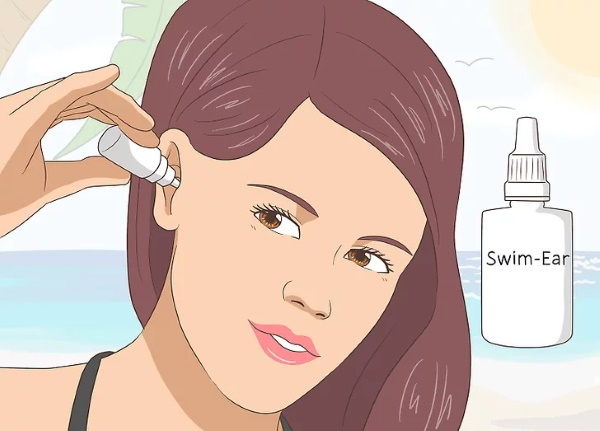
From folk remedies, anti-inflammatory chamomile tincture gives a good result. It eliminates otitis media and quickly removes fluid from the ear canal. Another effective remedy is a weakly concentrated solution of felled salt. It must be used with caution as it irritates the mucous membrane and the thin skin of the acoustic organ. To prepare a solution at the desired concentration, 1/4 hour is required. l. table salt.
This amount is recommended to be diluted with 250 ml of boiling water. The solution must be cooled to room temperature. Then they lie on the side opposite to the congestion and 3-4 drops of the agent are injected into the auricle with a medical pipette. Within 5 min. liquid should run out.
When should you see a doctor?
The help of an otolaryngologist will be required if the methods described above did not bring the expected result. If water from a natural reservoir enters the auditory canal, infection with pathogenic bacteria and the development of an inflammatory process are possible. Tap liquid is not capable of harming the acoustic organ and provoking complications.
The situation is dangerous when:
- chronic otitis media;
- injured drum membrane;
- dystrophic condition of the mucous membrane;
- broken integrity of the skin;
- the content of chemically aggressive substances in the water.
Professional medical assistance is necessary if, after the manipulations described above, the liquid continues to remain in the structure of the acoustic organ.
The reason for an emergency appeal to a medical institution is hearing impairment and a constant sensation of tinnitus.
Complications in the form of purulent discharge, an unpleasant odor, severe itching in the area of the lobe, cartilage and the inner surface of the auricle are of great danger to health. You should immediately consult an otolaryngologist if you develop shooting and throbbing pains, a noticeable swelling of the sulfur plug.
What to do to prevent the situation from repeating itself?
Using a sealed rubber cap while bathing or swimming will help prevent water from entering the ear canal. The reason for the easy penetration of fluid into the structure of the ear organ is the peculiarities of its anatomical structure. It is recommended to such people, even while washing their hair, to use special waterproof earplugs made of soft medical silicone. Fungal infections alter the function of the villi.
As a result, these physiological elements do not repel water, but do not retain it. If fluid flows into the acoustic channel on a regular basis, you should consult your doctor. It is necessary to regularly clean the ears of sulfur deposits that prevent moisture from pouring out of the auditory tube.
Video on how to remove water from the ear
How to properly remove water from your ear:


